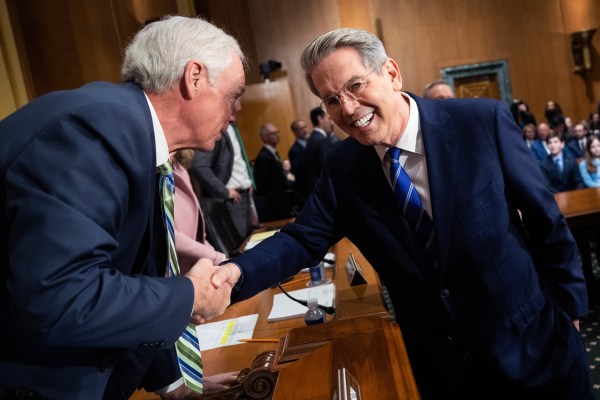With House passage of the GOP’s tax-and-spending megabill, all eyes turn to the Senate and the crucial decision its Republican leaders must make: either mostly accede to the bill it receives, or rewrite major sections of it. Central to the debate will be the House bill’s contentious proposed changes to Medicaid, which would partially roll back some of the rapid recent growth in the program to make some room for the party’s fiscal priorities (tax cuts, immigration enforcement, and defense). Those changes may well, in time, squeak through the Senate, even as the party’s continued rudderless approach to health care policy leaves it vulnerable to criticism.
The Republican Medicaid plan, as it is currently written, takes steps toward restraint but also would move several million low-income individuals into uninsured status. The savings for the bill as it headed to the House floor—$635 billion over 10 years, according to the Committee for a Responsible Federal Budget—were devoted to lowering the costs of the bill’s major tax cut. House Speaker Mike Johnson agreed to several last-minute changes to ensure the bill’s passage that will increase its estimated savings from Medicaid, but also the number of people expected to become uninsured.
For fiscal reasons, it is clear that Medicaid needs reform, but the context will matter to the public too. A plan which makes accessing beneficial medical care more challenging for the poor in order to hit budgetary targets is likely to face strong opposition.
The context.
Medicaid is the third member of the entitlement triumvirate now dominating the federal budget. Together with Social Security and Medicare, spending on the big three has risen from 3.7 percent of GDP in 1970 to 10.8 percent in 2024. Moreover, the Congressional Budget Office (CBO) projects their combined spending will rise to about 15 percent of GDP in 2054. All other spending in the budget is expected to be basically flat or falling over this period.
Enrollment growth in Medicaid is an important part of the entitlement story. In 2013, average Medicaid monthly enrollment stood at 59.8 million. By 2023, it had grown to 99.2 million (it has since fallen to 78.5 million thanks to stepped-up eligibility screens).
Congress and the first Trump administration are partly responsible for this surge, as they approved suspension of Medicaid reverification rules during the COVID-19 pandemic, which meant new people kept entering the program but no one left it. The Biden administration welcomed this development because it wanted to reduce the number of people going without any insurance using whatever levers were available to it, which led it to delay turning the reverification process back on even when it was clear the worst period of the pandemic was long past. It also issued a rule to provide 12 months of eligibility before reverification by the states would be required.
This emphasis on coverage during the Biden term, which also led to liberalizations in the Affordable Care Act’s premium credit program, had the intended effect. In 2023, the number of uninsured under age 65 was 25.3 million, or 9.5 percent of the total population below that age threshold, which was a historic low. In 2013, just before the ACA’s main provisions went into effect, there were 44.4 million uninsured under the age of 65.
The rise in Medicaid sign-ups has far exceeded the drop in the uninsured because of the iron law of entitlement benefits, which is that, once benefits are in place, individuals adjust their personal financial arrangements to qualify for government assistance. In particular, many millions of low-wage workers found their way into the program even though in previous years their employers may have covered them with a job-based plan. Medicaid charges no premium and very little cost-sharing, which means many potential beneficiaries see it as a more attractive option than what is offered in the commercial market. Some of the newly eligible changed jobs or adjusted their hours of work, because it was worth it to them to get fully subsidized health coverage rather than pay premiums for less generous job-based insurance.
Another truism of entitlements is that, once expanded, the politics shift rapidly toward protecting the status quo. In the case of Medicaid, that means that some in the GOP who resisted the ACA’s expansion are now resigned, or even supportive, of it, largely because they have heard from the millions of newly eligible how important Medicaid has become to their quality of life. Sen. Josh Hawley has taken the lead in making the case that Republicans should drop their resistance to a vastly expanded Medicaid program.
Still, there are holdouts in the party who believe fiscal stability demands a more aggressive commitment to reform. Their goal is to return Medicaid as much as possible to its pre-ACA remit of providing support to low income and low asset individuals who are disabled, age 65 and older, or single parents with young children. The difficulty for them is that the party has no broader plan for improving American health care, which means they have no answer when they are pressed on what alternative insurance arrangement they would offer to people made ineligible for Medicaid by their preferred changes.
While the House bill represents an uneasy intraparty compromise between these warring camps, it leans more toward the Hawley position, and might yet move still further in that direction as the legislation is taken up by the Senate.
Beyond coverage.
Although Medicaid’s role in insurance coverage gets most of the political attention, the program does far more than that. It is the country’s primary source of financing for nursing home stays and more broadly pays most of the costs for medical and non-medical services for the long-term disabled of all ages. In 2022, Medicaid spent an average of $21,300 per person on the elderly and disabled and just $5,000 for children, single parents, and non-disabled adults under age 65. Some of the megabill’s lower-profile provisions affect these aspects of the program.
The House measure also reaches into the complex mechanics defining the financial relationship between the federal and state governments as they split the burden of Medicaid’s bills. With decades of experience, states have become adept at maximizing federal funding while also minimizing their own contributions.
The main provisions.
President Trump set the tone for the debate by saying he wanted Medicaid changes to target waste, fraud, and abuse—but not benefits. Republicans will argue they complied with that stipulation, but their critics will argue the facts show otherwise.
The bill’s most important changes fall into three basic categories.
- Work requirements and immigration. The two most consequential provisions in the House bill would reduce program enrollment relative to current law. Beginning in 2027, all states would be required to implement work-related criteria when determining eligibility for non-disabled individuals age 19 to 64 who are not caring for dependents. To qualify, applicants must show they are working or engaged in work-related activities at least 80 hours per month. States must check on compliance at least twice per year, and there is no possibility of getting permission through a federal waiver to drop these eligibility conditions.
Further, states would be discouraged from using their own resources to enroll immigrants who do not have a current legal authority to reside in the U.S. States that continue with such programs would face a reduction in the federal matching rate from 90 to 80 percent for the costs of the individuals added to the program by the ACA’s expansion of eligibility to persons with incomes below 138 percent of the federal poverty line. It is likely this hefty financial penalty will force most of the participating states to drop their programs.
Based on the original start date of 2029 for the work requirements, the Congressional Budget Office (CBO) had estimated these two provisions would reduce projected Medicaid spending by about $291 billion over 10 years, or roughly 41 percent of the total savings expected from all of the bill’s Medicaid amendments. Moving the work requirements up by two years will increase the savings.
- Reversal of Biden rules. The bill delivers an additional $190 billion in savings over 10 years, or 26 percent of the total, by suspending implementation of three Biden-era rules. Two streamlined the enrollment process (and thus made it easier for more people to sign up) and the third established minimum staffing requirements for nursing homes. The House bill suspends implementation of these rules through 2034.
- Modifications to the federal matching rules. States have relied heavily for three decades on provider taxes and special hospital payment terms to offload Medicaid costs onto the federal budget. Taxes paid by providers of services can be used by the states to cover their shares of the total bills. Separately, the states increase payment rates for the affected providers to cover the costs of the taxes they pay. On net, then, the states and the providers contribute nothing (or very little) to the costs of the affected services, while the federal government picks up nearly the entire tab, which is clearly not the intent when Congress established the matching system to divide costs between the two levels of government. The House bill would modestly tighten the rules governing these and related practices and prevent states from enhancing them in the future. The combined savings would be $196 billion over 10 years, or 27 percent of the total.
The insurance effect.
In addition to expanding Medicaid, the ACA also established a new premium subsidy program for households with incomes above Medicaid eligibility and no access to an affordable job-based plan. The Biden administration expanded this support too, by pushing through Congress a more generous schedule of subsidies for the coverage, which expires at the end of 2025, and also streamlined rules for signing up. Republicans appear to be lining up to oppose both of these liberalizations. The House bill would suspend the Biden rule making it easier to sign up, and Republicans can terminate the higher schedule of subsidies by failing to extend the law authorizing it. Both of these changes from current policy also would move millions of individuals from insured to uninsured status.
The combined effect of these changes on the total number of uninsured would be substantial. Before the last-minute changes to the House bill, the CBO estimated it would increase the number of uninsured in 2034 by 8.6 million people compared to current law, with 1.4 million coming from the disincentive for states to cover immigrants not authorized to be in the country.
In addition, if the more generous ACA premium support of recent years expires at the end of 2025, the number of uninsured in 2034 would be 3.8 million above a forecast based on continuation of current policy. Thus, the combined effect of these Trump-era Medicaid and ACA policies could be to increase the number of uninsured in 2034 by a total of 12.4 million people.
It is not surprising that opponents of the House bill are focusing their most intense criticism on this potential increase in uninsured Americans. Public opinion is likely to be on their side: Most Americans would prefer not to return to the days of less enrollment in public coverage and more people living without insurance protection.
Republicans will argue the public supports work requirements, but that finding is based on the theoretical value of such a rule, not the reality of what will occur if it is imposed. When the policy was tested in the first Trump administration, it failed to deliver any tangible positive results, and certainly did not justify the high administrative costs. When the public becomes more aware that this policy leads to more eligible people losing coverage than to non-workers getting jobs, opinion is likely to shift toward opposition.
In the ACA debate, there was much back and forth around the actual value of health insurance to improvements in the health status of the insured, with insufficient empirical evidence to swing the consensus view one way or the other. More recent data, however, show what common sense would expect: All else being equal, it is far better for a person’s health to be enrolled in stable coverage than to be uninsured, with a major study finding that the ACA’s Medicaid expansion reduced the mortality risk of the newly eligible by 21 percent.
A flawed premise.
Congressional Republicans are right that Medicaid growth is contributing to persistent annual deficits, and that entitlement reform more generally is essential for a return to fiscal stability. But from that sound starting position they are steering a course that will be hard to defend.
Despite talk of fiscal restraint, the overall bill will add trillions more to federal debt over the coming decade because the tax cuts far exceed the spending cuts. According to the Committee for a Responsible Federal Budget, the House bill (before the last-minute changes) will increase the budget deficit by a combined $3.1 trillion over 10 years (including interest payments on the debt) and $5.1 trillion if the numerous temporary tax cuts and spending increases are made permanent. This legislation is in the running to be the most expensive ever enacted by Congress.
Republicans counter that faster growth from the tax cuts and the administration’s pullback of costly regulations will deliver the revenue needed to keep deficits from soaring. But their assumptions of growth—2.6 percent annually—are well outside the consensus and therefore not reliable when building a serious plan. Moreover, even if the economy grew as Republicans now predict it will, the added revenue would be insufficient to bring deficits down to sustainable levels.
Further, the Medicaid provisions in the emerging legislation highlight once again that the GOP has not developed a realistic plan for health care that can rival what guides the Democrats. Republicans want to reduce Medicaid’s projected costs, and it appears not to matter if the result is a sharp reversion back to the high numbers of people going without insurance that existed prior to the enactment of the ACA. The public would far prefer the GOP to develop reforms that lower costs for all purchasers of medical services rather than advance changes that lower the government’s costs at the expense of vulnerable households.
In sum, it is hard to see what is taking place in Congress as justified based on any sensible criteria.
The House bill reduces taxes in a disorganized fashion, with most of the benefits accruing to the well-off. To partially pay for the tax plan, the bill’s authors would impose more restrictions primarily on Medicaid and the Supplemental Nutrition Assistance Program (SNAP). All together, according to CBO, households with incomes in the bottom 10 percent would see a reduction of 4 percent in their resources in 2027 while the top 10 percent would see a 4 percent improvement. There is little doubt that Democrats will make these findings a central theme in future campaigns.
What’s needed is more than just tweaks to the House bill. The GOP should revisit the premise upon which the legislation was based, which is that extending the tax cuts from 2017, with no offsets, is essential to the American economy’s continued vitality. It isn’t. The federal government is in a deep fiscal hole that is becoming a serious threat to the country’s sustained prosperity. Congress should be working on a plan to restrain future deficits, not widen them, and such a plan is sure to require more revenue, not less. Tax reform that does not make the fiscal problem worse should be the objective.
There also is a great need to reform the entitlement programs, but blocking more low-income people from securing stable insurance is unnecessary to achieve that goal. Instead, Congress should be working on plans to bring more cost discipline to the entire health sector so that cost pressures recede in Medicare, Medicaid, and the commercial market.
Of course, moving in this new direction would be challenging and likely would require working with Democrats. Which is to say, it is not in the cards in the current environment, and may not be for the foreseeable future. But acknowledging the very long odds for this preferred course does not mean that passing any plan is better than no plan. The country would be better off if nothing of consequence passed at this point, forcing Congress to approve short-term extensions of the status quo instead. Further digging now will only make it harder to get out of an already very deep hole later.






Please note that we at The Dispatch hold ourselves, our work, and our commenters to a higher standard than other places on the internet. We welcome comments that foster genuine debate or discussion—including comments critical of us or our work—but responses that include ad hominem attacks on fellow Dispatch members or are intended to stoke fear and anger may be moderated.
With your membership, you only have the ability to comment on The Morning Dispatch articles. Consider upgrading to join the conversation everywhere.